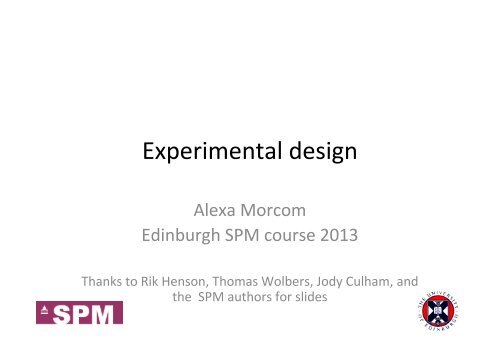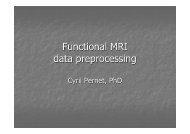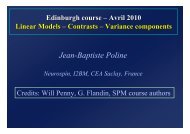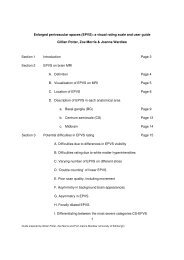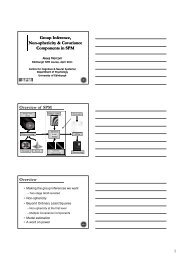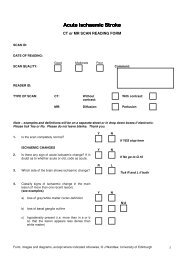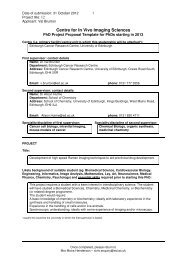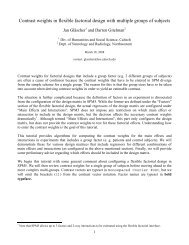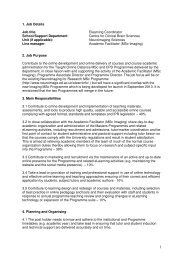Experimental design - Brain Research Imaging Centre Edinburgh
Experimental design - Brain Research Imaging Centre Edinburgh
Experimental design - Brain Research Imaging Centre Edinburgh
- No tags were found...
You also want an ePaper? Increase the reach of your titles
YUMPU automatically turns print PDFs into web optimized ePapers that Google loves.
<strong>Experimental</strong> <strong>design</strong>Alexa Morcom<strong>Edinburgh</strong> SPM course 2013Thanks to Rik Henson, Thomas Wolbers, Jody Culham, andthe SPM authors for slides
Overview of SPMImage Image timeseriestimeseriesDesign Design matrix matrixContrastsPreprocessingGenerallinearmodelSPMsTemplateKernel KernelVariancecomponentsThresholding
Overview• Categorical <strong>design</strong>s• Factorial <strong>design</strong>s• Parametric <strong>design</strong>s• fMRI adaptation• Control condition• Paradigm timing
Isolating a processSubtraction logic and assumption of pure insertion• Compare task conditions differing in a single process• Measure the time the process takes• Assume that addition of the component processdoes not alter other task componentsDonders (1898-9)
Pure insertion
Cognitive subtraction
Cognitive subtraction
Categorical <strong>design</strong>sPrinciple• Subtract two conditions to isolate a process• Assume that addition of the component processdoes not alter other task components• So adding the process into different tasks shouldproduce the same change in activity• (and: meaningful cognitive theory)
Categorical <strong>design</strong>sSimple subtraction• Detect regions specialised for a function bytesting for activation difference
Categorical <strong>design</strong>sSerial subtraction• Several cognitive processes in picture namingSee Friston et al. chapter in Human <strong>Brain</strong> Function (I)
<strong>Experimental</strong> <strong>design</strong>Categorical <strong>design</strong>s
Problem:Categorical <strong>design</strong>s
Factorial <strong>design</strong>sInteractions• The whole (task) is more than the sum of its(interdependent) processes• A modulates B• Vary A and B independently
Factorial <strong>design</strong>s
Conjunction <strong>design</strong>Two task pairs• B – viewing concrete objects and saying “yes”• C – naming concrete objectsDifference = phonological retrieval PLUS interactionwith object recognition• B2 – viewing coloured shapes saying “yes”• C2 – naming colour of coloured shapesDiff = phonological retrieval PLUS interaction withvisual analysis
Conjunction <strong>design</strong>Overlap isolates the process of interest• Phonological retrieval• NOT its interactions with visual processingOverlap of 4 subtractionsPrice & Friston (1997)
Conjunction <strong>design</strong>sDetecting overlapping processing• Encoding faces, different objects• Reactivation of same regions when face,object memories retrievedMVPA recall studyPolyn et al. (2005)
Parametric <strong>design</strong>sA continuously varying parameter• Systematic variation in activity with processengaged to varying degrees• Specific: e.g. Linear? Quadratic?• Avoids pure insertion but does assume noqualitative change in processing• Often less sensitive
Parametric <strong>design</strong>sARest + 5 rates of auditory word presentationBPET study• Auditory words,varying rate• Linear relationshipof rate withactivity in primaryauditory cortexPrice et al. (1992)
Parametric <strong>design</strong>sModel based fMRI• Computational model provides neurometricfunction e.g. Rescorla-Wagner predictionerror• Model comparisonGlascher & O’Doherty (2010)
Parametric factorial <strong>design</strong>sPsychophysiological interaction in V5z = -9Friston et al. (1997)• V1 activity =parametric(physiological)predictor• Attention tomotion =categorical(psychological)predictor
fMRI adaptation• Repetition suppression• = reduced BOLD response to repeated stimuli• Accompanies priming (behavioural)
fMRI adaptationRepetition suppression as a tool• fMRI – typical voxel = 10,000s of neurons• FFA – a mix, tuned to diff. face orientations?• Or: all viewpoint-invariant?
fMRI adaptationRelease from adaptation => sensitivity to the changed feature
fMRI adaptationOrientation tuning in human LOCIdent. Trans. Rotate
Control conditionProblem• fMRI is a contrastive method – for many<strong>design</strong>s, you need a control• ‘Rest’ isn’t no processing in many areas
Control conditionDifferent stimuli and taskDifferent stimuli similar task+‘Marilyn’Wonder if I leftthe gas on…?‘Female’‘Female’Same stimuli different taskSimilar stimuli same task‘Female’‘Seen before’‘Female’‘Female’ Choice of a baseline depends on your question!
Control conditionStark & Squire (2001) PNAS
Paradigm timingAnalysis of whole blockLarge effects (=efficient)Optimal length = 16 sec(sluggish BOLD vs. lowfrequency confounds)Analysis of single itemsSmaller effectsSOA from min ~= 2 sec
Paradigm timingAdvantages of event-related <strong>design</strong>• Intermixing of conditions avoids unwantedpsychological effects e.g. habituation, expectancy,loss of concentration
BlockedDataModelO = Old WordsN = New WordsO1O2O3RandomisedN1N2N3O1 N1 O2 O3N2
Paradigm timingAdvantages of event-related <strong>design</strong>• Intermixing of conditions avoids unwantedpsychological effects e.g. habituation, expectancy,loss of concentration• Post-hoc classification of trials, e.g. Subsequentmemory effect
Paradigm timing
Paradigm timingAdvantages of event-related <strong>design</strong>• Intermixing of conditions avoids unwantedpsychological effects e.g. habituation, expectancy,loss of concentration• Post-hoc classification of trials, e.g. Subsequentmemory effect• Some events can only be indicated by subject atparticular time e.g. Spontaneous perceptual changes
Number of Perceptual Reversals201510500 5 10 15 20Inter−Reversal Time (s)25201510500 5 10 15 20Inter−Reversal Time (s)
Paradigm timingAdvantages of event-related <strong>design</strong>• Intermixing of conditions avoids unwantedpsychological effects e.g. habituation, expectancy,loss of concentration• Post-hoc classification of trials, e.g. Subsequentmemory effect• Some events can only be indicated by subject atparticular time e.g. Spontaneous perceptual changes• Some events cannot be blocked, e.g. oddball
SummaryA few principles, one main take-home message• Different <strong>design</strong>s for different questionsWant to know more?• Temporal <strong>design</strong> efficiency• Design optimisation Advanced course (Wednesday)


